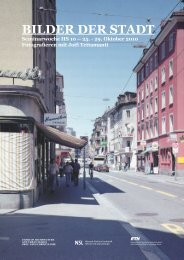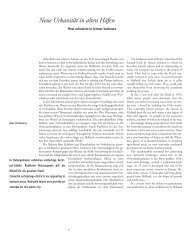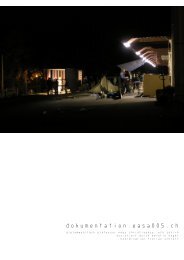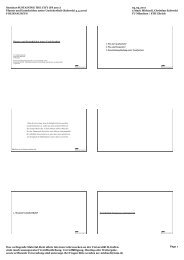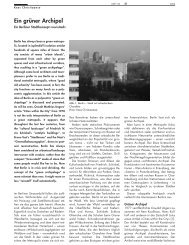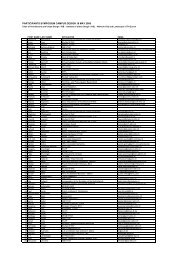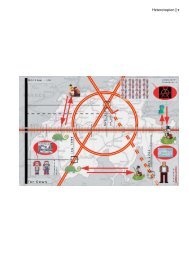Vitra, Weil am Rhein
Vitra, Weil am Rhein
Vitra, Weil am Rhein
You also want an ePaper? Increase the reach of your titles
YUMPU automatically turns print PDFs into web optimized ePapers that Google loves.
Corporate C<strong>am</strong>pus<br />
<strong>Vitra</strong><br />
Founded: 1950<br />
Berlin<br />
<strong>Weil</strong> <strong>am</strong> <strong>Rhein</strong><br />
Number of employees: ~850<br />
Revenue: 220 m EUR<br />
<strong>Vitra</strong> C<strong>am</strong>pus<br />
Train Station<br />
Train Station<br />
<strong>Vitra</strong> C<strong>am</strong>pus<br />
Train Station <strong>Weil</strong> <strong>am</strong> <strong>Rhein</strong><br />
Motto: Come and visit us!<br />
Founded: 1981 redevelopment<br />
Location: The <strong>Vitra</strong> C<strong>am</strong>pus is situated some way outside the city of <strong>Weil</strong> <strong>am</strong><br />
<strong>Rhein</strong> in Germany, in the triangle formed by the borders to Switzerland and France.<br />
A range of cultures, languages and mentalities have grown together into a com-<br />
mon economic area, whereby the wide variety of businesses in the area enjoy both<br />
price and tax advantages as well as a diverse consumer market. Centred on Basel,<br />
the urban area has a population of around 750,000 and is known for its cross-bor-<br />
der economic ties. The area’s transport infrastructure is unique in that it includes<br />
Development: The <strong>Vitra</strong> C<strong>am</strong>pus is an industrial complex where furniture is<br />
manufactured and displayed. The company is exemplary for the diversity<br />
of its products, which have been designed by personalities with individual style.<br />
The wide spectrum includes established n<strong>am</strong>es such as Charles and Ray<br />
E<strong>am</strong>es, deconstructivists like Robert Venturi, and newcomers like Werner Aiss-<br />
linger. This spirited, almost wild array of products is also reflected in the<br />
architecture on c<strong>am</strong>pus. <strong>Vitra</strong> has worked almost exclusively with upcoming<br />
architects, resulting in the creation of a prestigious architectural landscape<br />
on its factory premises. <strong>Vitra</strong>’s enthusiasm for architecture began in 1981 when<br />
Nicholas Grimshaw was hired to develop a master plan for the entire site<br />
after a major fire destroyed a significant part of the compound. Three functional<br />
factories were constructed as part of a homogeneous plan. Grimshaw’s<br />
high-tech architecture matched <strong>Vitra</strong>’s image as a company of high technical<br />
quality. This corporate identity strategy was challenged in 1984 after the<br />
head of the company, Rolf Fehlbaum, met Frank O. Gehry at the installation of<br />
Claes Oldenburg and Coosje van Bruggen’s sculpture Balancing Tools on<br />
c<strong>am</strong>pus. Discussions with Gehry led to a new strategy without a uniform appear-<br />
ance: “Different, but not arbitrary architectures should meet and distinguish<br />
<strong>Vitra</strong>, <strong>Weil</strong> <strong>am</strong> <strong>Rhein</strong> [DE]<br />
298 ports along the Rhine in addition to conventional highway, rail and air routes.<br />
this place through their vitality and uniqueness.” In this way – in contrast to the<br />
299
Corporate C<strong>am</strong>pus<br />
<strong>Vitra</strong> C<strong>am</strong>pus in <strong>Weil</strong><br />
<strong>am</strong> <strong>Rhein</strong><br />
surrounding industrial area of <strong>Weil</strong> <strong>am</strong> <strong>Rhein</strong> – the company decided to under-<br />
score the purpose of the company through the quality of its architecture.<br />
Progr<strong>am</strong>me: A number of buildings, including production halls as well as mar-<br />
keting and exhibition venues, were realised in the following years by international<br />
architects who were enabled by <strong>Vitra</strong> to build their first European projects.<br />
Gehry realised the expressive <strong>Vitra</strong> Design Museum with an associated factory<br />
hall, Zaha Hadid created the dyn<strong>am</strong>ic fire station, which is used today for events<br />
and the presentation of ‘100 Masterpieces’ from the Design Museum collection,<br />
Tadao Ando a meditative conference pavilion for seminars and training sessions,<br />
and Alvaro Siza a pseudo-purist production hall. Recently this open-air ‘archi-<br />
tecture museum’ has become home to two more historic icons: a Buckminster<br />
Fuller dome and a gas station by Jean Prouvé, which Rolf Fehlbaum discovered<br />
by chance on a tour through France. In addition to this, Eva Jiricna installed<br />
a Network/Living Office in one of Grimshaw’s factory halls, where innovative<br />
office systems are tested by <strong>Vitra</strong> employees and new ideas are explored.<br />
Morphology: <strong>Vitra</strong> has made a lively environment with this contrasting ensemble<br />
is no conventional attempt at corporate identity architecture based on brand re-<br />
cognition and power plays, but rather a stimulating architectural landscape,<br />
which encourages interaction between employee, product, work environment,<br />
client and visitor. This reciprocal relationship has a positive influence on the<br />
products, the urban context and the firm’s image. In addition, cultural topics are<br />
addressed and communicated through the changing exhibits in the Design<br />
Museum, the Design Workshops, and through events and tours of the c<strong>am</strong>pus<br />
architecture that make the company’s identity tangible and experiential. The<br />
<strong>Vitra</strong> C<strong>am</strong>pus is a spatial representation of the values of the company, where the<br />
brand itself becomes a destination – a magnet with cult status for clients and<br />
all those with a passion for architecture and design.<br />
The City of <strong>Weil</strong> <strong>am</strong> <strong>Rhein</strong>: <strong>Weil</strong> <strong>am</strong> <strong>Rhein</strong> is located in the southwestern corner<br />
of Germany, close to the borders of Switzerland and France. Two highways form<br />
the main transport arteries through the town. However, the most important<br />
transport routes are s the shipping routes along the Rhine and another highway<br />
which turns into a Swiss highway. Another important factor in the region is<br />
the Basel-Mulhouse-Freiburg airport, which connects the region with the rest of<br />
<strong>Vitra</strong>, <strong>Weil</strong> <strong>am</strong> <strong>Rhein</strong> [DE]<br />
Fire Station by Zaha<br />
Hadid (1993), Canopy<br />
between Assembly<br />
Hangar by Alvaro<br />
Siza (1993) and<br />
Manufacturing Hall<br />
300 as well as by interlinking production, culture, exchange and experiment. The result<br />
Europe and beyond.<br />
301<br />
by Nicholas<br />
Grimshaw (1982),<br />
and the <strong>Vitra</strong> Design<br />
Museum by Frank<br />
O. Gehry (1989).



